|
FORD FAIRLINE History
Introduction: Introduced
in 1955 as Ford's fullsize model, the Ford Fairlane was reborn in 1962
as Ford's entry into the hotly contested intermediate muscle car market.
With lighter weight than the fullsize Galaxie but with the same powerful
engines, the Fairlane, and its spinoffs the Torino and Cobra, were a force
to be reckon with on the street and the drag strip.
1955 Ford Fairlane
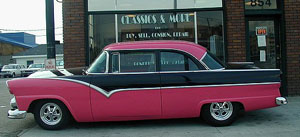 Comments:
The Ford Fairlane, named for Henry Ford's Fair Lane mansion in Dearborn,
was introduced in 1955 as the new top of the line fullsize Ford. The Fairlane
was offered in six different body styles and flavors, from the rare plastic
top Crown Victoria, to the convertible Sunliner and steel-top Victoria
hardtop coupe, to finally traditional sedans. All body styles featured
fine styling with the rakish "Fairlane stripe" side trim and optional flashy
two-tone paint. Although over shadowed by the mid 50s Chevy's, the Fairlane
were solidly designed (though sometimes sloppily assembled) and relatively
quick in V8 form. Comments:
The Ford Fairlane, named for Henry Ford's Fair Lane mansion in Dearborn,
was introduced in 1955 as the new top of the line fullsize Ford. The Fairlane
was offered in six different body styles and flavors, from the rare plastic
top Crown Victoria, to the convertible Sunliner and steel-top Victoria
hardtop coupe, to finally traditional sedans. All body styles featured
fine styling with the rakish "Fairlane stripe" side trim and optional flashy
two-tone paint. Although over shadowed by the mid 50s Chevy's, the Fairlane
were solidly designed (though sometimes sloppily assembled) and relatively
quick in V8 form.
Production: 2D Club
Sedan: 173,311. 4D Town Sedan: 254,437. Victoria 2D Hardtop: 113,372. Crown
Victoria: 33,165. Crown Victoria (plastic top): 1,999. Sunliner Convertible:
49,966.
Engines: 223 I6 120
bhp. 223 I6 137 bhp. 272 V8 162 bhp. 272 V8 182 bhp.
1956 Ford Fairlane
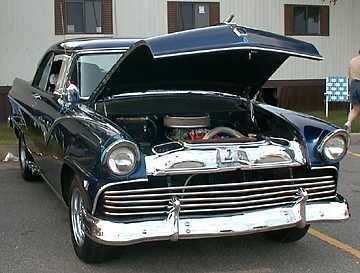 Comments:
A new four door Victoria hardtop was added for 1956. Of bigger interest
to performance fans was the introduction of two new V8s, a 292 cid and
a 312 cid. Comments:
A new four door Victoria hardtop was added for 1956. Of bigger interest
to performance fans was the introduction of two new V8s, a 292 cid and
a 312 cid.
Production: 2D Club
Sedan: 142,629. 4D Town Sedan: 224,872. Victoria 2D Hardtop: 117,735. Victoria
4D Sedan: 32,111. Crown Victoria: 9,209. Crown Victoria (plastic top):
603. Sunliner Convertible: 58,147.
Engines: 223 I6 120
bhp. 223 I6 137 bhp. 272 V8 162 bhp. 272 V8 182 bhp. 292 V8 200 bhp. 312
V8 215 bhp. 312 V8 225 bhp.
1957 Ford Fairlane
500
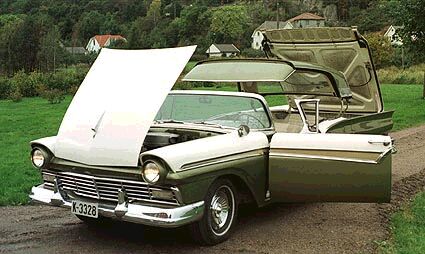 Comments:
The Ford Fairlane gained a new top trim for 1957, the 500. Sharing a new
118 inch wheelbase with standard Fairlane hardtops and sedans, which was
two inches longer than the junior Custom/Custom 300 models and the new
separate Station Wagon line. The new design was longer, lower, and wider
in typical '50s style, with many styling cues from the 1955 Mystere show
car. The Fairlane sported bigger, weightier new bodies matched by lower-profile
"cowbelly" frame with dropped rear floorpan and kicked-up aft siderails
permitting a two inch reduction in overall height. The suspension was improved
via swept back front lower control arms and longer rear leaf springs. All
engines were carryover from 1956, though tuned for slightly more power. Comments:
The Ford Fairlane gained a new top trim for 1957, the 500. Sharing a new
118 inch wheelbase with standard Fairlane hardtops and sedans, which was
two inches longer than the junior Custom/Custom 300 models and the new
separate Station Wagon line. The new design was longer, lower, and wider
in typical '50s style, with many styling cues from the 1955 Mystere show
car. The Fairlane sported bigger, weightier new bodies matched by lower-profile
"cowbelly" frame with dropped rear floorpan and kicked-up aft siderails
permitting a two inch reduction in overall height. The suspension was improved
via swept back front lower control arms and longer rear leaf springs. All
engines were carryover from 1956, though tuned for slightly more power.
But the star introduction
for 1957 was the new Ford Fairlane 500 Skyliner which featured the world's
first (and until the 1990s the only) production retractable hardtop convertible.
It seemed like a great idea (and a typical '50s one at that), but it proved
to be very complicated and somewhat trouble prone. It was also expensive,
0 more than the convertible Sunliner. Ford stylists designed the roof
to be shorter than on other models and its front section was hinged to
fold for more compact storage in the larger trunk area. But the Skyliner
still ended up with a higher, longer rear deck and bulgier "bustle" rear
panel. It also differed from other Ford Fairlanes with its standard V8,
a relocated gas tank (behind the back seat instead of under the trunk floor),
and little luggage space when the top was down.
Production: 2D Club
Sedan: 93,756. 4D Town Sedan: 193,162. Victoria 2D Hardtop: 183,202. Victoria
Hardtop Sedan: 68,550. Sunliner Convertible: 77,726. Skyliner Hardtop Convertible:
20,766.
Engines: 223 I6 144
bhp. 272 V8 190 bhp. 272 V8 205 bhp. 292 V8 212 bhp. 312 V8 245 bhp. 312
V8 270 bhp.
1958 Ford Fairlane
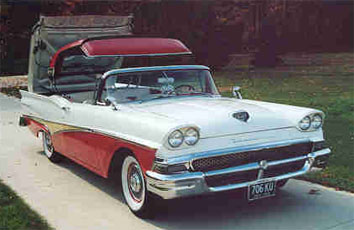 Comments:
The Ford Fairlane received a facelift for 1958, with quad headlamps above
a 1958 Thunderbird style front bumper and grille, broader side trim, scalloped
rear deck, four oval taillamps, and longitudinal roof ribs (to strengthen
those panels, a '57 weakness). Main mechanical advances were new "big block"
332/352 V8s, which replaced the old 292 and 312 V8s, and a more sophisticated
three-speed Cruise-O-Matic self-shift transmission. The retractable hardtop
Skyliner continued with the same changes as other Fairlanes. Comments:
The Ford Fairlane received a facelift for 1958, with quad headlamps above
a 1958 Thunderbird style front bumper and grille, broader side trim, scalloped
rear deck, four oval taillamps, and longitudinal roof ribs (to strengthen
those panels, a '57 weakness). Main mechanical advances were new "big block"
332/352 V8s, which replaced the old 292 and 312 V8s, and a more sophisticated
three-speed Cruise-O-Matic self-shift transmission. The retractable hardtop
Skyliner continued with the same changes as other Fairlanes.
Production: 2D Club
Sedan: 34,041. 4D Town Sedan: 105,698. Victoria 2D Hardtop: 80,349. Victoria
Hardtop Sedan: 14,713. Sunliner Convertible: 35,029. Skyliner Hardtop Convertible:
14,713.
Engines: 223 I6 144
bhp. 272 V8 190 bhp. 272 V8 205 bhp. 332 V8 240 bhp. 332 V8 265 bhp. 352
V8 300 bhp.
1959 Ford Fairlane
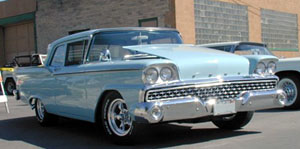 Comments:
Ford styling reached a high point for 1959, with a complete redesign of
the 57-58 styling. Noticeably squared up lines featured bigger windshields,
"gullwing" headlamp brows, and a "Flying V" back panel cradling large round
taillamps. Still, the styling was somewhat tame compared to the "bat wing"
look of the Chevrolet fullsize models. New for 1959 was the introduction
of the Galaxie trim, which appeared mid-year as a pair of Fairlane 500
hardtops with rectangular, wide-quarter Thunderbird-style roof lines --
a design theme that Ford would use for several years and be widely copied
by others. The Skyliner Hardtop Convertible and Ford Fairlane 500 Sunliner
convertible also were officially part of the Galaxie series, even though
they still wore Fairlane 500 script badging. The V8s were slightly detuned
in deference to buyers made more economy conscious by the recession of
1958. Suspension tweaks improved ride at the expense of handling, but workmanship
improved, and durability was served by no-wax "Diamond Lustre" enamel paint
and long life aluminized mufflers. This was the last year for the Skyliner
Hardtop Convertible. Comments:
Ford styling reached a high point for 1959, with a complete redesign of
the 57-58 styling. Noticeably squared up lines featured bigger windshields,
"gullwing" headlamp brows, and a "Flying V" back panel cradling large round
taillamps. Still, the styling was somewhat tame compared to the "bat wing"
look of the Chevrolet fullsize models. New for 1959 was the introduction
of the Galaxie trim, which appeared mid-year as a pair of Fairlane 500
hardtops with rectangular, wide-quarter Thunderbird-style roof lines --
a design theme that Ford would use for several years and be widely copied
by others. The Skyliner Hardtop Convertible and Ford Fairlane 500 Sunliner
convertible also were officially part of the Galaxie series, even though
they still wore Fairlane 500 script badging. The V8s were slightly detuned
in deference to buyers made more economy conscious by the recession of
1958. Suspension tweaks improved ride at the expense of handling, but workmanship
improved, and durability was served by no-wax "Diamond Lustre" enamel paint
and long life aluminized mufflers. This was the last year for the Skyliner
Hardtop Convertible.
Production: 500 Victoria
Sedan: 9,308. 500 Victoria Hardtop Coupe: 23,892. Galaxie Victoria Hardtop
Sedan:
47,728. Galaxie Victoria Hardtop Coupe: 121,869. Sunliner Convertible:
45,868. Skyliner Hardtop Convertible: 12,915
Engines: 223 I6 145
bhp. 292 V8 200 bhp. 332 V8 225 bhp. 352 V8 300 bhp.
1960 Ford Fairlane
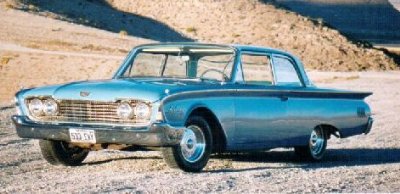 Comments:
The fullsize Fairlane was redesign for 1960 and were six inches longer,
almost five inches wider, and nearly 200 pounds heavier. Graceful styling
helped to hide some of the heft, with a sloped hood, simple grille, straight
A-pillars, clean chrome-edged fenderlines, and modest horizontal tailfins,
noding to Chevy's 1959 "batwings." The Sunliner returned, but the new Starliner
was a real surprise: a pillarless semi-fastback two-door hardtop which
replaced 1959's square-roof version. Comments:
The fullsize Fairlane was redesign for 1960 and were six inches longer,
almost five inches wider, and nearly 200 pounds heavier. Graceful styling
helped to hide some of the heft, with a sloped hood, simple grille, straight
A-pillars, clean chrome-edged fenderlines, and modest horizontal tailfins,
noding to Chevy's 1959 "batwings." The Sunliner returned, but the new Starliner
was a real surprise: a pillarless semi-fastback two-door hardtop which
replaced 1959's square-roof version.
Production: Starliner
Hardtop Coupe: 68,461. Sunliner Convertible: 44,762
Engines: 223 I6 135
bhp. 223 I6 145 bhp. 292 V8 175 bhp. 292 V8 185 bhp. 352 V8 300 bhp. 352
V8 360 bhp.
1961 Ford Fairlane
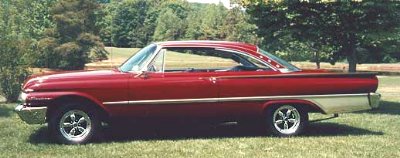 Comments:
The Ford Fairlane models were redesigned again for 1961 and were slightly
shorter and lighter, and tastefully made over with a concave grille, reshaped
hood, more rounded bodysides, and a return to large, round taillamps. Performance
improved with the introduction of a 390 cid V8 option good for either 375
or 401 bhp. Comments:
The Ford Fairlane models were redesigned again for 1961 and were slightly
shorter and lighter, and tastefully made over with a concave grille, reshaped
hood, more rounded bodysides, and a return to large, round taillamps. Performance
improved with the introduction of a 390 cid V8 option good for either 375
or 401 bhp.
Production: Starliner
Hardtop Coupe: 29,669. Sunliner Convertible: 44,614
Engines: 223 I6 135
bhp. 223 I6 145 bhp. 292 V8 175 bhp. 292 V8 185 bhp. 352 V8 300 bhp. 352
V8 360 bhp. 390 V8 375 bhp. 390 V8 401 bhp.
1962 Ford Fairlane
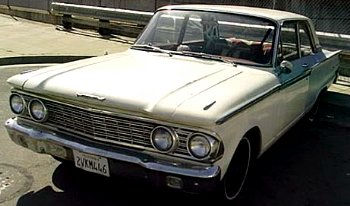 Comments:
The previously fullsized Ford Fairlane was reborn in 1962 as Ford's entry
into the intermediate class. The new midsize Fairlane was nearly one foot
shorter than the fullsize Galaxie, and eight inches longer than the compact
Falcon. Also new was a new innovative, lightweight V8 created using a technique
known as thin-wall casting. Initially displacing 221 cid, the Fairlane
V8 was 90 lb. lighter and much more compact than the popular Chevrolet
small block V8. In mid-year 1962, Ford introduced the Fairlane 500 Sports
Coupe with standard bucket seats and a mini console. Optional was the 260
Challenger V8, a bored out version of the 221. Comments:
The previously fullsized Ford Fairlane was reborn in 1962 as Ford's entry
into the intermediate class. The new midsize Fairlane was nearly one foot
shorter than the fullsize Galaxie, and eight inches longer than the compact
Falcon. Also new was a new innovative, lightweight V8 created using a technique
known as thin-wall casting. Initially displacing 221 cid, the Fairlane
V8 was 90 lb. lighter and much more compact than the popular Chevrolet
small block V8. In mid-year 1962, Ford introduced the Fairlane 500 Sports
Coupe with standard bucket seats and a mini console. Optional was the 260
Challenger V8, a bored out version of the 221.
1963 Ford Fairlane
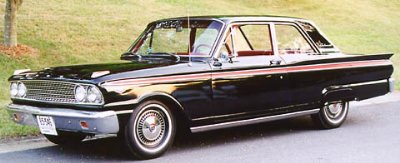
Comments: New for
1963 was the introduction of the 289 V8 engine, a bored out version of
the 260. The 289 was rated at up to 271 bhp in optional "High Performance"
trim.
1964 Ford Fairlane
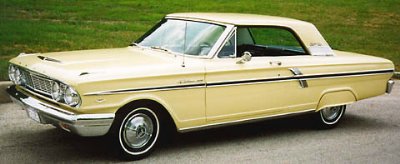 Comments:
The most exciting news of 1964 was a special Fairlane model designed for
serious drag strip racing. Ford teamed up with Andy Hotten, of Dearborn
Steel Tubing Co., to build 57 Fairlane based 427 powered race cars with
a weight of around 3,203 lbs to compete on professional drag strips. These
cars had fiberglass fenders, teardrop-shaped hood blisters (to clear the
competition 427's high rise manifold and air cleaner), Plexiglass windows,
lightweight police-package bucket seats, an air induction system with air
intakes where the inner headlights used to be, 8,000 rpm Rotunda tachs,
modified front suspensions (to fit the 427), and many special competition
equipment features. Sunvisors, mirror, sound-deadening, armrests, even
the jack and lug wrench were removed to save weight. The 425 bhp 427 big
block was heavily modified and actually cranked out around 500 bhp. It
was linked to a beefed-up Lincoln automatic with 4.58:1 gearing or a Borg
Warner T-10 transmission with Hurst shifter with 4.44:1 gearing. Massive
traction bars, asymmetrical rear springs, and a trunk mounted 95 pound
bus battery helped to get all that power to the ground. The 1964 Ford Fairlane
Special Performance Drag vehicles soon adopted the Thunderbolt name from
the 1963 A/FX Fairlane drag race car and were also known as "T-bolts."
Demand was strong enough to lead to a second order of 54 all white cars.
Driver Gas Ronda dominated NHRA's 1964 World Championship by running his
T-bolt through the quarter mile in 11.6 seconds at 124 mph. Of the 111
total built, at least 99 of them had manual transmission, and the first
11 were painted maroon, the rest were white. Comments:
The most exciting news of 1964 was a special Fairlane model designed for
serious drag strip racing. Ford teamed up with Andy Hotten, of Dearborn
Steel Tubing Co., to build 57 Fairlane based 427 powered race cars with
a weight of around 3,203 lbs to compete on professional drag strips. These
cars had fiberglass fenders, teardrop-shaped hood blisters (to clear the
competition 427's high rise manifold and air cleaner), Plexiglass windows,
lightweight police-package bucket seats, an air induction system with air
intakes where the inner headlights used to be, 8,000 rpm Rotunda tachs,
modified front suspensions (to fit the 427), and many special competition
equipment features. Sunvisors, mirror, sound-deadening, armrests, even
the jack and lug wrench were removed to save weight. The 425 bhp 427 big
block was heavily modified and actually cranked out around 500 bhp. It
was linked to a beefed-up Lincoln automatic with 4.58:1 gearing or a Borg
Warner T-10 transmission with Hurst shifter with 4.44:1 gearing. Massive
traction bars, asymmetrical rear springs, and a trunk mounted 95 pound
bus battery helped to get all that power to the ground. The 1964 Ford Fairlane
Special Performance Drag vehicles soon adopted the Thunderbolt name from
the 1963 A/FX Fairlane drag race car and were also known as "T-bolts."
Demand was strong enough to lead to a second order of 54 all white cars.
Driver Gas Ronda dominated NHRA's 1964 World Championship by running his
T-bolt through the quarter mile in 11.6 seconds at 124 mph. Of the 111
total built, at least 99 of them had manual transmission, and the first
11 were painted maroon, the rest were white.
Production: Thunderbolt:
100
Engines: 427 V8 425
bhp @ 6000 rpm, 480 lb-ft @ 3700 rpm.
Performance: Thunderbolt:
427/425: 1/4 mile in 11.76 seconds.
1966 Ford Fairlane
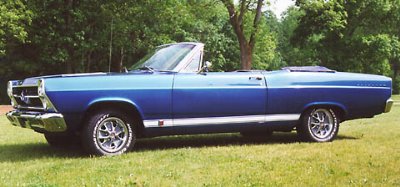 Comments:
New for 1966 was the introduction of the GT and GTA packages, as well as
the addition of a new convertible body style in addition to the two door
hardtop. The Fairlane was redesigned to fit Ford's FE big block V8s for
the first time. GTs came with 390 cid V8s as standard, the GTA added the
SportShift Cruise-O-Matic automatic transmission. The GT and GTA packages
were available on the 500/XL line and also included special badges, a special
hood, body striping, engine dress-up parts, heavy-duty suspension, disc
brakes, bucket seats, console and a sport steering wheel. The base 335
bhp V8 featured a hot cam, special manifolds, and a single four barrel
carb. Approximately 60 Fairlanes were made with "side oiler" 427 wedge
engines. Cars equpped with the 427 included a big air scoop at the front
of the hood. The 427 was available in two versions: a single four barrel
carb, good for 410 bhp, or with dual quad carbs which was rated at 425
bhp. Fitting the 427 required relocated shock towers and larger front coil
springs. Free-breathing cast iron exhaust headers, low-restriction dual
exhassts, and Ford's top-loader four-speed manual completed the powertrain.
The 427 was only available on the two door Fairlane 500s or 500XLs and
it came with a lift-off fiberglass hood with functional air scoop, small
fender insignia, a Special Handling package, manual front disc brakes,
longer rear leaf springs, larger bias-belted blackwall tires, and a 9,000
rpm tach. On the dragstrip, these cars could do the quarter mile in under
13 seconds at almost 114 mph. Comments:
New for 1966 was the introduction of the GT and GTA packages, as well as
the addition of a new convertible body style in addition to the two door
hardtop. The Fairlane was redesigned to fit Ford's FE big block V8s for
the first time. GTs came with 390 cid V8s as standard, the GTA added the
SportShift Cruise-O-Matic automatic transmission. The GT and GTA packages
were available on the 500/XL line and also included special badges, a special
hood, body striping, engine dress-up parts, heavy-duty suspension, disc
brakes, bucket seats, console and a sport steering wheel. The base 335
bhp V8 featured a hot cam, special manifolds, and a single four barrel
carb. Approximately 60 Fairlanes were made with "side oiler" 427 wedge
engines. Cars equpped with the 427 included a big air scoop at the front
of the hood. The 427 was available in two versions: a single four barrel
carb, good for 410 bhp, or with dual quad carbs which was rated at 425
bhp. Fitting the 427 required relocated shock towers and larger front coil
springs. Free-breathing cast iron exhaust headers, low-restriction dual
exhassts, and Ford's top-loader four-speed manual completed the powertrain.
The 427 was only available on the two door Fairlane 500s or 500XLs and
it came with a lift-off fiberglass hood with functional air scoop, small
fender insignia, a Special Handling package, manual front disc brakes,
longer rear leaf springs, larger bias-belted blackwall tires, and a 9,000
rpm tach. On the dragstrip, these cars could do the quarter mile in under
13 seconds at almost 114 mph.
Production: 500XL
GT 2D Hardtop: 33,015. 500XL GT Convertible: 4,327
Engines: 390 V8 335
bhp. 427 V8 410 bhp. 427 V8 425 bhp @ 6000 rpm, 480 lb-ft @ 3700 rpm.
Performance: 427/425:
0-60 in 6.0 seconds, 1/4 mile in 14.5 seconds @ 100 mph.
1967 Ford Fairlane
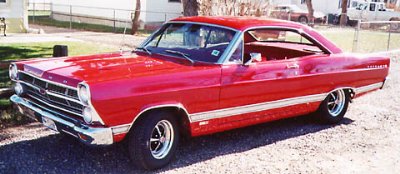 Comments:
The Fairlane had minor trim changes with a slightly redesigned grille.
The small block 289 cid V8 became the standard engine for the GT/GTA, with
the 390 cid V8 with either two or four barrel carb as optional, rated at
275 bhp and 320 bhp (15 bhp less than the previous year) respectively.
Still available was the 427 "side oiler" which this year featured tunnel-port
heads and a dual quad carb option for racing use only. The air flow improvement
with this setup added an additional 30 bhp. All Fairlane GT/GTAs gained
standard power front disc brakes and had all vinyl interiors with bucket
seats standard. Comments:
The Fairlane had minor trim changes with a slightly redesigned grille.
The small block 289 cid V8 became the standard engine for the GT/GTA, with
the 390 cid V8 with either two or four barrel carb as optional, rated at
275 bhp and 320 bhp (15 bhp less than the previous year) respectively.
Still available was the 427 "side oiler" which this year featured tunnel-port
heads and a dual quad carb option for racing use only. The air flow improvement
with this setup added an additional 30 bhp. All Fairlane GT/GTAs gained
standard power front disc brakes and had all vinyl interiors with bucket
seats standard.
Production: 500XL
GT 2D Hardtop: 18,670. 500XL GT Convertible: 2,117
Engines: 289 V8 200
bhp. 390 V8 275 bhp. 390 V8 320 bhp.
1968 Ford Fairlane
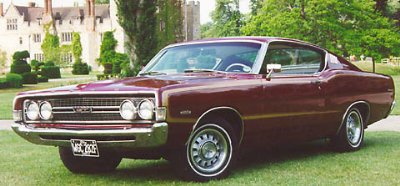 Comments:
The Ford Fairlane was redesigned for 1968. Although it retained its 116
inch wheelbase, it grew in almost every other dimension, and became nearly
a fullsize car. There was a new fastback "Sportsroof" model and a new sporty
Torino series. The GTs were included in the Torino line and included a
standard 302 cid V8, bucket seats, console, name badges, specific striping
and trim, deluxe wheelcovers, and a lighting package. Muscle car options
included a 390 cid V8, and the 390 bhp 427 cid V8 for the first half of
the year. It was replaced mid-year by the new Cobra Jet 428, rated at 335
bhp. A Super Cobra Jet version was also available. Comments:
The Ford Fairlane was redesigned for 1968. Although it retained its 116
inch wheelbase, it grew in almost every other dimension, and became nearly
a fullsize car. There was a new fastback "Sportsroof" model and a new sporty
Torino series. The GTs were included in the Torino line and included a
standard 302 cid V8, bucket seats, console, name badges, specific striping
and trim, deluxe wheelcovers, and a lighting package. Muscle car options
included a 390 cid V8, and the 390 bhp 427 cid V8 for the first half of
the year. It was replaced mid-year by the new Cobra Jet 428, rated at 335
bhp. A Super Cobra Jet version was also available.
Production: Torino
GT 2D Fastback: 74,135. Torino GT 2D Hardtop: 23,939. Torino GT Convertible:
5,310
Engines: 302 V8 210
bhp. 302 V8 220 bhp. 302 V8 230 bhp. 390 V8 265 bhp. 390 V8 335 bhp. 427
V8 390 bhp.
1969 Ford Fairlane
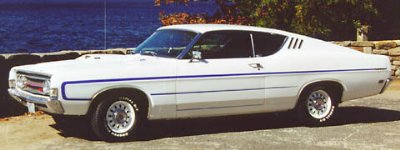 Comments:
Modestly restyled, the three Torino GTs returned in 1969 with two new Torino
Cobra models. Standard equipment equipment included the 302 cid V8, three
speed manual transmission, styled wheels, GT stripes and ornamentation,
a heavy-duty suspension, and wide oval tires. A 320 bhp 390 and two 428s
with 335 bhp were available. Bucket seats were now optional. The new Cobra
was designed as a budget street racer that would compete against the Plymouth
Road Runner and thus packed a lot of performance in a no frills package.
The Cobra had less trim than the GT, but had a big snake decal (later a
metal badge) on its front fenders. Standard was the 428 cid Cobra Jet V8,
rated at 335 bhp (though it really put out around 400 bhp). A four-speed
manual transmission (automatic was just more), beefed-up suspension,
wide wheels, fat tires, hood scoop, black grille and Cobra ID were included.
Options included bucket seats, and a functional hood scoop that fed fresh
air into the engine (which didn't affect the engine's rating but definitely
added more power). A clock, tachometer, power disc brakes, and gearing
up to 4.30:1 with Detriot Locker, were also extra. Comments:
Modestly restyled, the three Torino GTs returned in 1969 with two new Torino
Cobra models. Standard equipment equipment included the 302 cid V8, three
speed manual transmission, styled wheels, GT stripes and ornamentation,
a heavy-duty suspension, and wide oval tires. A 320 bhp 390 and two 428s
with 335 bhp were available. Bucket seats were now optional. The new Cobra
was designed as a budget street racer that would compete against the Plymouth
Road Runner and thus packed a lot of performance in a no frills package.
The Cobra had less trim than the GT, but had a big snake decal (later a
metal badge) on its front fenders. Standard was the 428 cid Cobra Jet V8,
rated at 335 bhp (though it really put out around 400 bhp). A four-speed
manual transmission (automatic was just more), beefed-up suspension,
wide wheels, fat tires, hood scoop, black grille and Cobra ID were included.
Options included bucket seats, and a functional hood scoop that fed fresh
air into the engine (which didn't affect the engine's rating but definitely
added more power). A clock, tachometer, power disc brakes, and gearing
up to 4.30:1 with Detriot Locker, were also extra.
Also new for 1969 was the
introduction of the Torino Talladega to better compete on the NASCAR Grand
National super speed ways. Named for the Alabama town where a new 2.66
mile track was to open, the Torino Talladega was based on the SportsRoof
two door hardtop and got an extended sloped nose, flush grille, revised
rear bumper used in front, and reworked rocker panels, all to improve aerodynamics.
The result was a car nearly six inches longer and one inch lower than stock.
Power came from the 335 bhp Cobra Jet 428 cid FE big block V8, but only
the C-6 Cruise-O-Matic automatic transmission was available. Production
totaled 754 units (easily meeting the required 500 requirement), and was
available in wimbleton white, royal maroon, or presidential blue. The black
interiors only had bench seats.
Production: Torino
GT 2D Fastback: 61,319. Torino GT 2D Hardtop: 17,951. Torino GT Convertible:
2,552
Engines: 302 V8 210
bhp. 302 V8 220 bhp. 302 V8 230 bhp. 351 V8 250 bhp. 351 V8 290 bhp. 390
V8 265 bhp. 390 V8 335 bhp. 428 V8 335 bhp.
Performance: Torino
Cobra 428/335: 0-60 in 5.5 seconds, 1/4 mile in 14.4 seconds @ 101 mph.
1970 Ford Fairlane
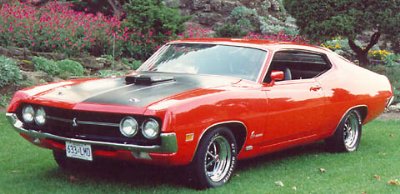 Comments:
The Ford Fairlane was restyled again for 1970, growing again as wheelbase
increased from 116 to 117 inches, length increased by six inches, and width
increased by two inches. A full lineup was available, topped by the Torino
Cobra. Standard on the Torino Cobra was the new big block 429 with four
barrel carb and 10.5:1 compression rated at 360 bhp. Cobras came with Ford's
top-loader four-speed manual transmission (capped by a Hurst shifter),
competition suspension with staggered rear shocks, seven-inch steel wheels,
F70-14 rubber, a black hood with locking devices, black out trim, and Cobra
badging. Bench seats were standard. Engine options included the 370 bhp
Cobra 429 with 11.3:1 compression, different heads, a high-lift cam, and
a 700-cfm Holley four barrel carb on a high rise manifold. The 429 could
also be order with functional Ram Air (which was called the Cobra-Jet Ram
Air 429) but was still rated at 370 bhp. Ordering the Drag Pack with the
Cobra engine added Traction-Lok 3.91:1 or Detroit Locker 4.30:1 gears,
a mechanical-lifter cam, oil cooler, forged aluminum pistons, four-bolt
mains, and a 780 cfm four barrel carb, good for 375 bhp. Also available,
briefly, was the 375 bhp Boss 429. On the street, the extra heft helped
traction off the line and the Torino Cobra's 0-60 times were quite competitive.
However, although the Torino Cobra was supposed to be used for NASCAR,
it was actually slower than the 1969 versions, which forced most race teams
to run the 1969 cars. Comments:
The Ford Fairlane was restyled again for 1970, growing again as wheelbase
increased from 116 to 117 inches, length increased by six inches, and width
increased by two inches. A full lineup was available, topped by the Torino
Cobra. Standard on the Torino Cobra was the new big block 429 with four
barrel carb and 10.5:1 compression rated at 360 bhp. Cobras came with Ford's
top-loader four-speed manual transmission (capped by a Hurst shifter),
competition suspension with staggered rear shocks, seven-inch steel wheels,
F70-14 rubber, a black hood with locking devices, black out trim, and Cobra
badging. Bench seats were standard. Engine options included the 370 bhp
Cobra 429 with 11.3:1 compression, different heads, a high-lift cam, and
a 700-cfm Holley four barrel carb on a high rise manifold. The 429 could
also be order with functional Ram Air (which was called the Cobra-Jet Ram
Air 429) but was still rated at 370 bhp. Ordering the Drag Pack with the
Cobra engine added Traction-Lok 3.91:1 or Detroit Locker 4.30:1 gears,
a mechanical-lifter cam, oil cooler, forged aluminum pistons, four-bolt
mains, and a 780 cfm four barrel carb, good for 375 bhp. Also available,
briefly, was the 375 bhp Boss 429. On the street, the extra heft helped
traction off the line and the Torino Cobra's 0-60 times were quite competitive.
However, although the Torino Cobra was supposed to be used for NASCAR,
it was actually slower than the 1969 versions, which forced most race teams
to run the 1969 cars.
The King Cobra, Ford's answer
to the Dodge Charger Daytona and Plymouth Superbird, never saw production.
Added to the Torino lineup was the Falcon trim, the lowest trim level of
the Fairlane/Torino lineup. It was possible to order the Falcon with the
Boss 429 engine rated at 375 bhp in a relatively light weight car. Boss
429 equipped Falcons could do 0-60 in 6 seconds, and 1/4 miles in 14.5
seconds. Elsewhere in the Torino lineup, engines were detuned for emissions,
mileage, and insurance reasons.
Production: Torino
GT: 56,819. Torino Cobra: 7,675.
Engines: 302 V8 220
bhp. 302 V8 250 bhp. 351 V8 285 bhp. 351 V8 300 bhp. 429 V8 360 bhp. 429
V8 370 bhp. 429 V8 375 bhp @ 5400 rpm, 450 lb-ft @ 3400 rpm.
Performance: Torino
Cobra 429/370: 0-60 in 6.0 seconds, 1/4 mile in 13.99 seconds @ 101 mph.
1971 Ford Fairlane
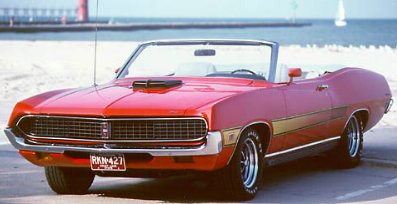
Comments: The 1971
Torinos were basically unchanged, but the standard engines were downgraded,
the GT from a V8 to an I6, and the Cobra from the 428 to a 351 Cleveland
V8. Still optional were the 429s, with and without Ram Air, but the Boss
429 was unavailable.
Production: Torino
GT: 31,641. Torino Cobra: 3,054.
Engines: 250 V6 145
bhp. 302 V8 220 bhp. 302 V8 250 bhp. 351 V8 285 bhp. 351 V8 300 bhp. 429
V8 360 bhp. 429 V8 370 bhp. 429 V8 375 bhp.
1972 Ford Fairlane
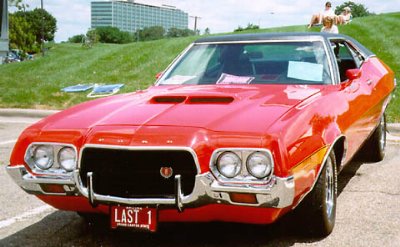
Comments: The 1972
Torinos were even larger, heavier, and more luxury oriented. Both Cobra
and convertibles were gone. The GT continued, but it was only a shadow
of its former self.
|